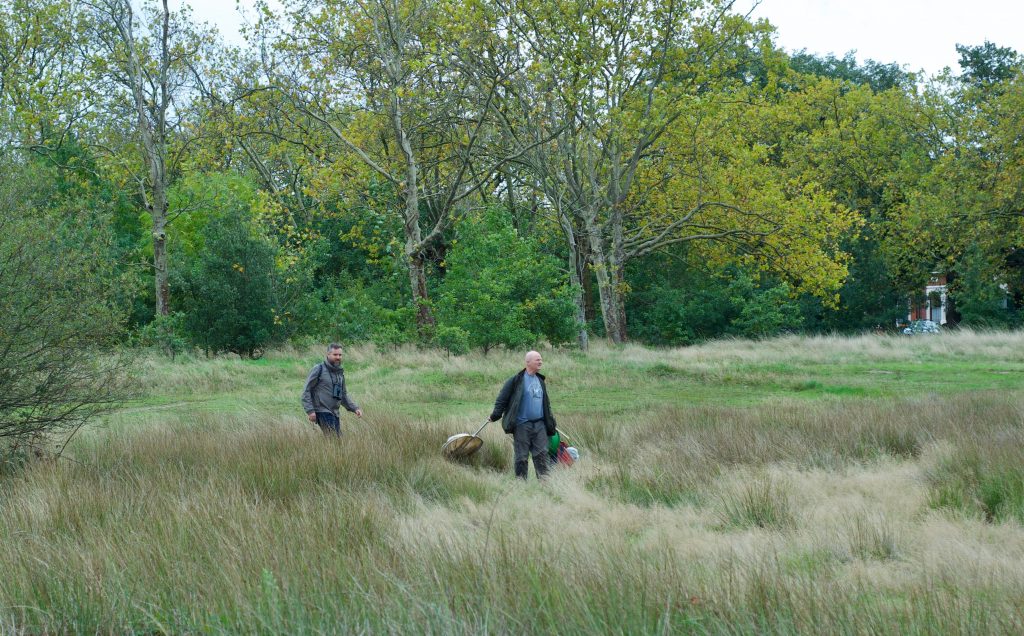Report by James Heal and all photos by Anke Marsh
On 13 October David Carr led the way with another spider field trip/survey on Wanstead Flats. This followed the very wet but successful trip on 27 July and a couple of solo visits he has made since. There were about nine of us: members of the Wren Wildlife & Conservation Group and the London Natural History Society.
Unfortunately, the day was another wet one as with the July visit, although it was luckily mainly just overcast and drizzly with one heavy shower. The focus of the visit was on the copses on the Flats (on this occasion, Long Wood and Coronation Copse) with a few spiders found nearby in the grassland, broom and scrub, and single specialist found on the margins of Angel/Bandstand Pond. David employed the methods of bush/tree beating, some sweep-netting, and some leaf-litter sorting. A number of the species mentioned below required microscopic examination for confirmation to species level.The July visit had been tantalising with a find of an immature spider suspected to be Anyphaena numida, a nationally rare buzzing spider. Whilst we were not able to confirm that find, David had a confirmed adult male on a solo visit a few weeks later. And so we were delighted to find another on the October trip by beating the same oaks where he found a specimen before on his own. There are only three species of the Anyphaena genus found in the UK, with two of them being very rare and recent finds for the UK, and all three having been found locally by David. Whilst A. numida was undoubtedly the rarest find of the day (only a handful of specimens have been confirmed nationally), David also found a number of other scarce and interesting spiders.
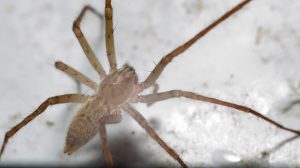
After meeting and gathering in Centre Road car-park, we began the spider-search in Long Wood, aptly named as a long and narrow bisected copse running from east to west along the northerly part of the largest section of Wanstead Flats and dividing the Brick Pit fields to the north from the broom field grasslands to the south.
In the first round of tree-tappings and undergrowth sorting, David quickly picked up Harpactea hombergi, a small stripey-legged woodlouse hunting spider. With the exception of the very rare, H. rubicunda, H. hombergi is the only species in its genus likely to be found in the UK.
We also found the very common Amaurobius similis in this location, the lace-webbed spider. I learned that ‘similis’ part of its binomial refers to its similarity to the closely related A. fenestralis. The latter is more likely than the former to be found away from human habitation, but on this occasion we clearly happened across a ‘wilder’ woodland specimen (albeit you are never very far from habitation on Wanstead Flats).
Another common ‘domestic’ species found in this bit of woodland was the large house spider, Eratigena sp atrica group (probably A. gigantea). A pale specimen was hiding in a crevice surrounded by leaf litter. We also found the false widow spider now almost ubiquitous in built-up areas in the South East; Steatoda nobilis.
In this environment we also came across one of the two species of pinkish goblin spiders, from the Oonops genus. David later confirmed that this was Oonops pulcher, a spider he had not previously recorded on Wanstead Flats.
It was no surprise to find the orbweb spider, Araneus diadematus (commonly called Garden Spider), on a web with its distinctive white cross-like shape on the abdomen. However, Anke Marsh, who had joined us for the day with her daughter, was particularly thrilled to find a lifer, Agalenatea redii, another orbweb spider on Broom just south of Long Wood (it was a also a lifer for me, but as a arachno-newbie, that is not a great surprise).
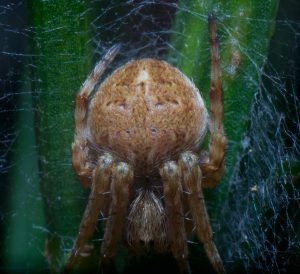
Just outside of the wooded areas we also found a chunky wolf spider that David identified for us as Trochosa terricola and the commonly-found nursery web spider, Pisaura mirabilis.
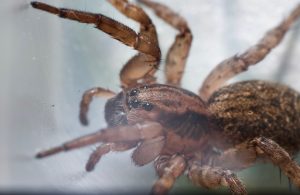
As the rain started again we went back into a wooded area to the east of the gap in Long Wood. This was where David had found Anyphaena numida a few weeks earlier and on the first few taps of the oak, we had an adult male. It is worth noting that there have still been fewer than 20 confirmed finds of this species in the UK.
David also got a likely immature Philodromus praedatus (one of the tricky running crab spiders) from the oak in the same location (Philodromus dispar was also recorded on the day, although I appear not to have been paying attention at that point as I have no photos of it). We also got to study one of the larger money spiders (Linyphiidae), which seems somewhat misnamed as Lepthyphantes minutus considering it is at least two or three times the size of an average expected money spider.
Another interesting find nearby, and another new species for the local area, was Megalepthyphantes sp. near collinus. This species has still to be fully studied and properly named in science (hence it is just a species similar to/“near” M. collinus) and has just a double digit set of records in the UK, all in the South East. David actually found and confirmed male and female specimens of this enigmatic species.
Heavy rain then temporarily stopped play and the small party of spider hunters adjourned to a nearby cafe for a spot of lunch. A little later when the rain was slightly less of an impediment to arachno-detecting, we went back to a different copse; known locally as Coronation Copse. David focused on sorting through the top layers of loose leaf litter. It was a productive method in a productive location.
Another linyphid appeared almost straight away: Microneta viaria, and things just got better from there. A chunky looking ground spider turned out to be Haplodrassus sylvestris, a woodland native that is not often recorded and has apparently been in decline, so lovely to find in a semi-urban site. This was another first for our location.
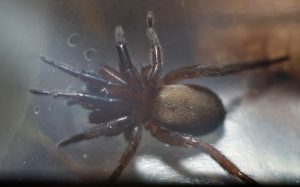
Next out of the leaf-litter was one of the ant-mimic spiders, Phrurolithus festivus. And then something truly remarkable came fell out of the plastic soil sieve. Another linyphid/money spider, a male with extraordinary boxing-glove-like pedipalps, and an even more extraordinary thin stalk-like protuberance on its head, which is where the male’s eyes are situated. The spider’s name is Walckenaeria acuminata.
There are a number of species in this genus, but surely none are quite as strange as this particular species.
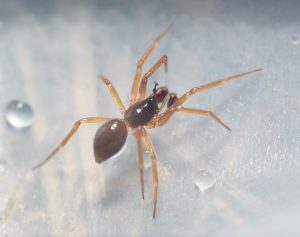
We also found another wolf spider, but did not identify it to species level, so it remains Pardosa sp in our records.
David and I then bid farewell to the last of our spider-finding team, Anke and her daughter, and made our way down to the swampy circle that used to be a small lake, called Angel. Sifting through the litter there did not seem to prove very productive until one small spider fell through the sieve. It was the last spider David found for the day and was not only new for the local area, but also a nationally scarce spider: a member of the Theridiidae (or ‘tangle web’) spiders, called Robertus arundineti.
Overall, it proved to be another great day of spider finds, yet again showing Wanstead Flats to be a fantastic location. I am sure we will organise further surveys/field trips in the future, so please do keep an eye out.
